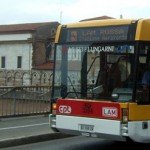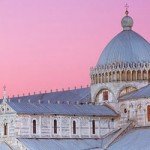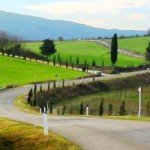Today, September 5, 2010, is the European Day of Jewish Culture. I admit that I don’t know much about Jewish culture, but I am deeply fascinated but such an ancient culture to which Cristian culture is also deeply indebted.
I have also always wanted to visit the Jewish Cemetery in Pisa. Even if it is unknown to most, it is just outside Piazza dei Miracoli, comprised between the city walls and the ever-crowded area where large groups of tourists gather to be picked up by their buses.
I walk by it several times every week, and for years I’ve been too lazy or too busy to actually step inside. For this reason, when we read that today the cemetery would be open to the public and that it would even be possible to have a guided tour, we decided that it was the perfect opportunity to see another piece of Pisa which we didn’t know.
I should probably start by saying that the Jewish community has a long history in Pisa: a 1150 year-long history to be precise. The first official mention dates back to the year 859 A.D.. The area of Pisa was among the first areas in Europe where Jewish communities settled and it is only second to the community in Rome in order of importance. The reason why so many Jews chose the Pisan area as their home is probably that at the time, Pisa was a major commercial center and they worked as intermediaries between the Christian and the Islamic communities in the trades in the Mediterranean.
The guide who showed us around told us that the presence of the Jewish community in Pisa in the Middle Ages is also evidenced by inscriptions on the city walls by the cathedral, which were probably a way to remember some members of the community who, for various reasons, could not be buried in the sacred ground.
At that time, the cemetery occupied an area of what is today property of University Hospital Santa Chiara, which was then outside the city walls. Moreover, a document of the 13th century obligated Jews to live all in the same area, which, by the way, was already occupied by the community. That was not a ghetto: everybody could live there, and trade could be carried out freely. At the beginning of the 14th century, as a matter of fact, the community moved to the area comprised between Via San Martino and Piazza Chiara Gambacorti.
Over the centuries, the city has always seen the presence of a Jewish community, who for hundreds of years controlled the financial life of the city, until the 17th century, when their activities were declared illegal by the Grand Duchy of Tuscany. Most of the Jews in Pisa became merchants, and many moved to Livorno, where the harbor was a livelier trade center.
In the 19th century the community started to grow again and it has been deeply integrated in the cultural scene in the city ever since.
The cemetery in Pisa is one of the most ancient Jewish burial grounds still in use. It was created in its present location in 1674 after Cosimo III de’ Medici decided to use the area where the older cemetery was located as a hunting area. Some of the old tombs were moved to the new locations. The oldest tomb stones of the 16th and 17th century are still standing. Their peculiarity is that on one side, they have Hebraic inscriptions, and on the other they have Spanish or Portuguese inscriptions because these people were the descendants of the families who had been expelled from the Iberian Peninsula in the 15th century.
The visit was very interesting. There are tombs of very different styles and epochs and inscriptions in many different languages which evidence the cosmopolitan character of the Pisan community.
Many tombs are damaged: like everything else in the city, the ground tends to sink, and many tombs have sunk or are broken.
I particularly liked the older part. It’s impressive, with many stones under the tall trees: it looks like you are far from the most touristy area of Pisa.
The area with the tombs of the many children who died during the plague in the 17th century is also impressive. We learnt that Jews don’t move their dead people, unlike Christians, so the old little tombs are all there. Many have stones on top. I thought they were just random pieces of other damaged graves, but they are in fact the equivalent of flowers. We were explained that bringing a stone to the grave of a beloved one is the same as bringing flowers, but contrary to flowers which fade easily, stones remain to witness the love of the living ones left behind.
I also found fascinating the double format of the dates in the inscriptions: the “normal date” and the Hebraic date. The new year begins on September 8th, and it will be 5771 if I am not mistaken.We naively asked how they start counting: the guide looked at us with a smile and calmly told us “the creation of the world of course“. Of course.
We bought a book about the community: the money will go towards the restoration of the old Synagogue of the city, dating almost 500 years: it was heavily damaged by a bad storm a few years back. Hopefully, next year, on the European Day of Jewish Culture they will be able to open the Synagogue to the public too. If you are willing to make a donation, here is the information: http://pisaebraica.it/cms/2008/12/09/emergenza-tetto/.
We really enjoyed the visit. I highly recommend a visit to this interesting, little-known place in Pisa, which is definitely on the beaten path and yet well off it!
Planning a trip to Tuscany? Check out our self-catering apartment in Pisa!















I feel like I’m always looking for interesting things to read about a variety of subjects, but I manage to include your blog among my reads every day because you have honest entries that I look forward to. Here’s hoping there’s a lot more amazing material coming!
I will be spending several days in Pisa this month and will go to see the cemetery if it’s open. Thanks for a thoughtful enlightening article.
Opening hours:
the cemetery is open twice a week,
Wednesdays and Sundays
10:00am-12:30pm
Grazie Giacomo!!
I visited the cemetery many years ago, when I was in Pisa for a meeting, and was enthralled. This is a lovely account of a fascinating place. Thank you for it, Gloria.